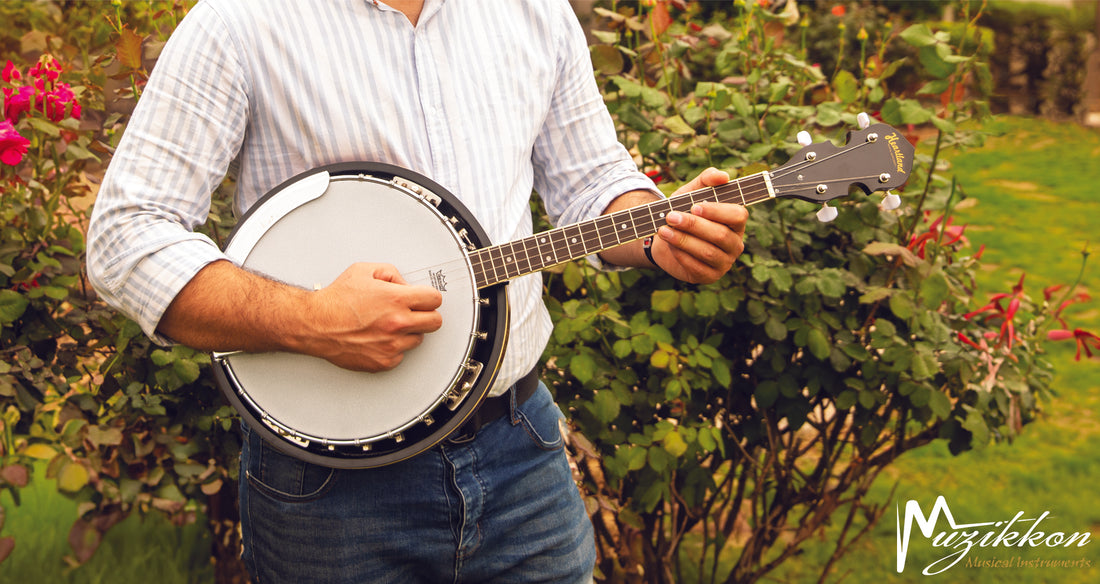¿Alguna vez te viene a la mente un instrumento banjo cuando piensas en música folclórica? El banjo es un instrumento de cuerda, elaborado con las mejores maderas y cuerdas que producen una música agradable. Este admirable instrumento puede hacer bailar el corazón de cualquiera con su sonido.
Lo que hace de Banjo una obra maestra es su conexión con la cultura afroamericana. Esta pieza musical estética cuenta su historia de cultura y tradiciones a través de su hermoso sonido. Su sonido clásico con un toque de cultura aún une al mundo, brindando un toque de historia y nostalgia.
Pero, ¿alguna vez te has preguntado dónde se conectan las raíces del banjo? Sin duda, su icónica melodía que nos tranquiliza el alma nos despierta la curiosidad por su historia y evolución. Entonces, profundicemos en la historia del banjo para conectar algunos puntos sobre su valor en el mundo de la música.
Historia del banjo y su importancia cultural
Todas las personas que aman la música del banjo y admiran este instrumento como una parte importante de su gusto musical deben escuchar su historia. Este blog lo llevará en un viaje fascinante, capturando todos los hechos de la historia del banjo. Entonces, prepárate y explora el lado informativo e interesante de tu ícono musical ideal.
Historia del banjo de cuerdas
La respuesta a la pregunta “¿El banjo se originó en África?” es SÍ. Hoy en día, casi todo el mundo está familiarizado con este instrumento de cuerda, pero es imprescindible escuchar su historia de origen. Aunque el banjo es un instrumento musical muy conocido a nivel mundial hoy en día, sus orígenes nos remontan a África Occidental.
Es más o menos la época en que la población local de África occidental solía fabricar instrumentos de cuerda con calabazas ahuecadas. Debajo de las cuerdas, solían estirar la piel del animal para obtener un mejor sonido en las primeras etapas de su producción.
Uno de estos instrumentos era conocido como “Akonting” y tenía de tres a cinco cuerdas. No sería un error decir que este instrumento representa el modelo inicial de los instrumentos banjo actuales. Como otros instrumentos de cuerda, el Akonting también se tocaba a través de su cuerda, pero no tenía diapasón, ya que no existía en África.
Datos históricos del banjo
Sin embargo, también encontrarás algunos datos oscuros sobre el desarrollo del banjo si profundizas en su historia. Los primeros instrumentos de banjo fueron inventados por los esclavos de África occidental y central en América en el siglo XVII.
Cuando el origen del banjo se introdujo en los EE. UU., inicialmente se consideró un instrumento de clase baja. Pero más tarde, las generaciones más jóvenes mostraron interés y aprendieron a tocar el banjo de sus esclavos mayores.
Entre esta generación más joven, Joel Walker Sweeney fue el primer niño que empezó a tocar el banjo en el escenario y contribuyó a hacerlo popular. También hizo un cambio en los banjos usando una caja de resonancia de madera en lugar de un cuerpo de calabaza, lo que lo acercó a su forma actual.
Además, uno de los hechos más importantes de la historia del banjo es que obtuvo reconocimiento mundial gracias al Minstrel Show de Estados Unidos. A partir de ese momento, el banjo experimentó algunas evoluciones icónicas, dejando al mundo asombrado.
La evolución del banjo
A lo largo del tiempo, se realizaron cada vez más cambios en los banjos y también se introdujeron diferentes tipos de banjos. Se hizo más amplificado y más común en las bandas musicales al rediseñarlo. La razón detrás de estos cambios fue que se había convertido en un requisito necesario que los instrumentos musicales tuvieran un volumen alto.
Además, el banjo atrajo más atención después de haber sido influenciado por otros instrumentos de cuerda como la guitarra y el violín. Su innovación también tuvo algunos añadidos, como trastes, resonadores, cuerdas de metal y algunos otros. Más tarde, la gente empezó a tocarlo más como un ritmo, similar a una guitarra.
Este cambio le hizo perder su quinta cuerda, ya que se tocaba con púa, dándole un nuevo nombre “Plectrum Banjo”. El banjo se hizo popular en Irlanda en la década de 1920 y era conocido como banjo tenor irlandés de 4 cuerdas. Allí empezó a utilizarse como instrumento melódico.
¿Cómo tocar un banjo de cinco cuerdas?
Aunque el banjo de 4 cuerdas se toca con mayor frecuencia en la música irlandesa, el banjo de 5 cuerdas aún no ha perdido su encanto en la música tradicional irlandesa. La mejor parte de tocar un instrumento banjo es que se puede tocar mediante varias técnicas. Las dos técnicas más comunes son “Clawhammer” y “Bluegrass”.
El estilo Clawhammer es creativo en el que presionas la cuerda con el pulgar y el dedo medio para marcar un ritmo. Crea un sonido atractivo que se utiliza principalmente en la música folclórica tradicional y calma los oídos de los entusiastas de la música. Incluso un principiante puede aprender fácilmente este estilo.
Mientras que la técnica Bluegrass es la más fácil de tocar con un banjo de 5 cuerdas porque tiene un patrón simple de punción con los dedos con una afinación en G abierta. Tocas su cuerda con dos dedos y el pulgar para lograr un sonido perfecto. Como sugiere el nombre, la impresionante melodía que surge a través de esta técnica se utiliza principalmente en los géneros bluegrass y country.
Diferentes tipos de banjos
Con el paso del tiempo, se introdujeron más tipos de banjos y se generaron expectación al ganarse el corazón de todos los amantes de la música a través de sus afinaciones versátiles. Su estructura corporal, afinaciones y una variedad de técnicas de interpretación contribuyen activamente a captar la atención de los fanáticos de la música.
Es más, la diversidad de estilos y tipos los hace perfectos para tocar en diferentes géneros musicales. Es por eso que todos los tipos de banjo se hicieron un lugar en cada uno de los siguientes géneros:
- Bluegrass
- País
- irlandés
- Gente
- Hierba garra
- Jazz tradicional
- Otros
Ahora, aquí hay algunos tipos destacados de banjos que debes explorar:
- Banjo de 5 cuerdas: banjo de 5 cuerdas es el tipo más común de banjos o también podrías considerarlos como los modelos estándar. Se pueden tocar en géneros musicales como country, jazz, rock, clásico y gospel.
- Banjos de púa: Es un banjo de cuatro cuerdas y 22 trastes con afinaciones en C, Sol, Si y Re. Este tipo de banjo se tocaba inicialmente con una púa, de ahí su nombre “Plectrum banjo”. Normalmente escucharás el banjo de púa en el género musical tradicional de jazz.
- Banjos de salón: estos son tipos de banjos súper fáciles de usar, más cortos y livianos. Estos lindos banjos son perfectos para principiantes ya que son fáciles de usar.
- Banjos de cuello largo: Los banjos de cuello largo también ocupan un lugar importante en los tipos de banjos. Su versatilidad es un factor destacado que los hace únicos, ya que puedes tocarlos en diversos estilos, como Clawhammer, Strumming, etc.
¿Quieres comprar un banjo de 5 cuerdas?
¿Estás buscando un banjo de 5 cuerdas fenomenal? Termine su búsqueda aquí si ese es el caso porque Muzikkon presenta instrumentos musicales de la más alta calidad a un precio razonable. Aquí también encontrará una colección completa de banjos, que es su colección preferida si está dispuesto a adquirir uno.
Esta colección contiene una variedad de categorías y estilos de banjos. No importa si eres un profesional o un principiante en tocar instrumentos banjo, nuestros increíbles banjos satisfarán tus necesidades. Desde banjos de púa y banjos tenor hasta banjos de cinco cuerdas y banjos resonador, definitivamente encontrará el mejor aquí.
¡Pero espera un momento! La parte más importante aún está por llegar. Muzikkon ofrece banjo de 5 cuerdas a la venta, lo que significa que ahora puede obtener su instrumento favorito al precio más asequible. Y la razonabilidad no afecta la calidad de estos instrumentos, por lo que puedes tener fácilmente un banjo de cinco cuerdas ideal a tu alcance.
Pensamientos finales
Dado que el banjo se ha convertido en la parte más importante de la industria musical, es necesario conocer su historia, origen y evolución. Desde los tiempos oscuros de los esclavos africanos hasta la era actual, el banjo ha ido ocupando un lugar permanente en los corazones de las personas.
Además, el banjo pasó por diferentes fases de evolución, gracias a los africanos occidentales que despertaron el interés por aprenderlo en las generaciones más jóvenes. Ya sea de 5 cuerdas, 4 cuerdas, de salón o cualquier tipo de banjo que te guste, lo más importante es saber qué te gusta. Por lo tanto, este blog te ayudará a aprender más sobre tu instrumento favorito y a moldear mejor tu interés por él.








